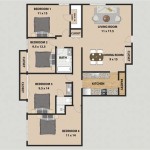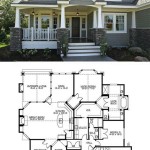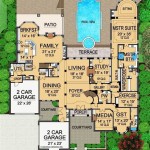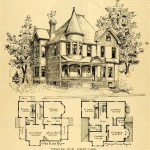Colonial Open Concept Floor Plans: A Harmonious Blend of Tradition and Modernity
The architectural landscape has witnessed a fascinating evolution, with homeowners increasingly seeking designs that seamlessly blend historical charm with contemporary functionality. Colonial open concept floor plans represent a popular manifestation of this trend, offering a unique approach to residential living that marries the elegance of Colonial architecture with the spaciousness and fluidity of open-concept design.
Colonial architecture, characterized by its symmetry, classic detailing, and emphasis on formal spaces, typically features compartmentalized rooms with distinct functions. Open-concept layouts, conversely, prioritize interconnectedness and flow, minimizing barriers between living areas. The synthesis of these seemingly disparate styles requires careful consideration and a nuanced understanding of the elements that define each.
The allure of Colonial open concept floor plans lies in their ability to offer the best of both worlds. They provide ample space for modern living while retaining the timeless appeal and historical character associated with Colonial design. This article delves into the key considerations, design elements, and benefits associated with creating a successful Colonial open concept floor plan.
Preserving Colonial Character in an Open Layout
The primary challenge in designing a Colonial open concept floor plan lies in maintaining the essence of Colonial architecture while embracing the principles of open-concept design. This requires a delicate balance, ensuring that the resulting space feels both cohesive and true to its historical sources.
One crucial aspect is the preservation of key architectural details that define the Colonial style. These details can include elements such as crown molding, wainscoting, raised paneling, and traditional window and door casings. Incorporating these features throughout the open space helps to establish a sense of continuity and reinforces the Colonial aesthetic.
Another important consideration is the use of appropriate materials and finishes. Opting for hardwood flooring, traditional paint colors, and period-appropriate hardware can further enhance the Colonial character of the space. The strategic placement of these elements is crucial to preventing the open layout from feeling too modern or stark.
The careful use of transitional elements can also help to define distinct zones within the open space without completely closing them off. For example, a partial wall or a strategically placed archway can subtly separate the living room from the kitchen while maintaining a visual connection between the two areas. Similarly, changes in flooring material or ceiling height can delineate different zones within the open layout.
Furniture selection plays a critical role in reinforcing the Colonial aesthetic. Choosing pieces that are consistent with the period, such as traditional sofas, chairs, and tables, can help to create a cohesive and harmonious design. Antique or reproduction furniture can also add to the historical authenticity of the space.
Lighting is another essential element to consider. Opting for traditional lighting fixtures, such as chandeliers, sconces, and table lamps, can complement the Colonial style and create a warm and inviting atmosphere. The placement of these fixtures should be carefully planned to provide adequate illumination while highlighting the architectural details of the space.
Finally, attention to detail is paramount. Small details, such as the choice of artwork, accessories, and textiles, can have a significant impact on the overall impression of the space. Selecting items that are consistent with the Colonial period can help to create a more authentic and historically accurate design.
Key Design Considerations for Open Concept Colonial Homes
Beyond preserving the Colonial aesthetic, several other design considerations are essential for creating a successful Colonial open concept floor plan. These considerations relate to factors such as space planning, functionality, and flow.
Effective space planning is crucial to ensure that the open layout is both functional and aesthetically pleasing. The arrangement of furniture and the definition of distinct zones should be carefully considered to maximize the use of space and create a comfortable living environment. The natural flow of movement through the space should also be taken into account, ensuring that the layout is intuitive and easy to navigate.
Zoning the open concept layout is critical to creating a sense of order and structure. This can be achieved through the use of furniture, architectural features, and changes in flooring or ceiling height. Defining distinct zones for activities such as cooking, dining, and relaxation can help to create a more functional and comfortable living space.
Maintaining a sense of visual coherence is also important. While the open layout should allow for distinct zones, it is essential to ensure that the space feels cohesive and unified. This can be achieved through the use of consistent color palettes, materials, and design elements throughout the open area.
Adequate storage is another important consideration. Open-concept layouts can sometimes lack the storage space found in traditional compartmentalized homes. Therefore, it is essential to incorporate creative storage solutions into the design, such as built-in cabinets, shelving units, and hidden storage compartments. These solutions should be both functional and aesthetically pleasing, blending seamlessly with the overall design of the space.
Acoustics are often overlooked in open-concept designs. The lack of walls can lead to excessive noise and echoes, which can be particularly problematic in homes with young children or those who enjoy entertaining. Incorporating sound-absorbing materials, such as rugs, curtains, and upholstered furniture, can help to mitigate these issues and create a more comfortable acoustic environment.
Natural light is a valuable asset in any home, but it is particularly important in open-concept layouts. Maximize the amount of natural light entering the space by installing large windows and skylights. The strategic placement of furniture and accessories can also help to distribute natural light throughout the open area.
Finally, consider the impact of the open layout on heating and cooling costs. Open spaces can be more challenging to heat and cool efficiently than compartmentalized homes. Therefore, it is essential to invest in energy-efficient windows, insulation, and HVAC systems. The strategic placement of ceiling fans can also help to improve air circulation and reduce energy consumption.
Benefits of Colonial Open Concept Living
The decision to embrace a Colonial open concept floor plan offers numerous benefits, appealing to homeowners seeking a blend of historical charm and modern functionality.
One of the primary advantages of open-concept living is the increased sense of spaciousness and connectedness. The absence of walls creates a more open and airy atmosphere, making the home feel larger and more inviting. This can be particularly beneficial for smaller homes or those with limited natural light.
Open-concept layouts also facilitate greater interaction and communication between family members. The absence of walls allows for easier supervision of children, making it easier for parents to keep an eye on their kids while preparing meals or working. It also promotes more casual and informal gatherings, creating a more relaxed and social atmosphere.
The flexibility of open-concept layouts is another significant benefit. The absence of permanent walls allows for greater flexibility in furniture arrangement and the use of space. This can be particularly appealing to homeowners who enjoy redecorating or those who anticipate changes in their lifestyle over time.
Open-concept designs can also enhance the flow of natural light throughout the home. The lack of walls allows for natural light to penetrate deeper into the interior, creating a brighter and more cheerful living environment. This can also help to reduce reliance on artificial lighting, saving energy and reducing utility bills.
The open flow also lends itself well to entertaining. Open-concept layouts provide ample space for guests to mingle and circulate, making it easier to host parties and gatherings. The seamless connection between the living room, dining room, and kitchen allows for a more interactive and inclusive entertaining experience.
Furthermore, a Colonial open concept floor plan can increase the resale value of a home. The combination of historical charm and modern functionality is highly desirable to many homebuyers, making homes with this type of layout particularly attractive. The increased sense of spaciousness and connectedness can also make the home feel more appealing to potential buyers.
Finally, open-concept living can promote a more relaxed and stress-free lifestyle. The absence of walls can create a sense of greater freedom and openness, reducing feelings of confinement and promoting a more positive and uplifting living environment. The ease of interaction and communication can also strengthen family bonds and create a more supportive and connected home life.

Pin Page

Renovation Ideas Playing With A Colonial S Floor Plan

Colonial Floor Plan 4 Bedrms 3 5 Baths 2537 Sq Ft 170 2549

2 Story Colonial Floor Plans Monmouth County Ocean New Jersey Rba Homes

Pin Page

2 Story Colonial Floor Plans Monmouth County Ocean New Jersey Rba Homes

House Plan 3 Bedrooms 2 Bathrooms 4756 Drummond Plans

Open Concept Center Hall Colonial Kitchen Remodel In Verona Wi Sweeney Design Build

Classic Colonial 1a Floor Plan Barn Home Davis Frame

Wright Robinson Architects








